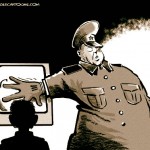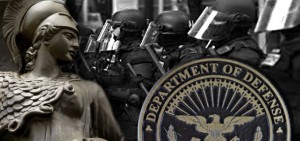– Ominous.
– I’ve thought for sometime now that the U.S. military would eventually try to block access by soldiers to social commentary and criticism so that they would remain motivated if they are asked to go out and suppress social unrest in the U.S.
– To be fair, in this article they are suppressing a different kind of information. But the principle is the same and what we see here will be the thin edge of the wedge making its entry.
– The kind of unrest we’re talking about here is what will surface in the U.S. eventually, if the gap between the rich and poor keeps growing, if the weakening of the U.S. dollar keeps undermining the very fabric of people’s entire financial lives (even as the wealthy walk away with immense profits) and if the growing threats of climate change are not addressed and hundreds of thousands of people along the U.S. coastlines begin to find their lives, their futures and their properties vanishing beneath the rising waters.
= = = = = = = = = = = = = = = = = = = = = = = = = = =
 The U.S. military is banning and blocking employees from visiting The Intercept in an apparent effort to censor news reports that contain leaked government secrets.
The U.S. military is banning and blocking employees from visiting The Intercept in an apparent effort to censor news reports that contain leaked government secrets.
According to multiple military sources, a notice has been circulated to units within the Army, Navy, Air Force, and Marine Corps warning staff that they are prohibited from reading stories published by The Intercept on the grounds that they may contain classified information. The ban appears to apply to all employees—including those with top-secret security clearance—and is aimed at preventing classified information from being viewed on unclassified computer networks, even if it is freely available on the internet. Similar military-wide bans have been directed against news outlets in the past after leaks of classified information.
A directive issued to military staff at one location last week, obtained by The Intercept, threatens that any employees caught viewing classified material in the public domain will face “long term security issues.” It suggests that the call to prohibit employees from viewing the website was made by senior officials over concerns about a “potential new leaker” of secret documents.
The directive states:
We have received information from our higher headquarters regarding a potential new leaker of classified information. Although no formal validation has occurred, we thought it prudent to warn all employees and subordinate commands. Please do not go to any website entitled “The Intercept” for it may very well contain classified material.
As a reminder to all personnel who have ever signed a non-disclosure agreement, we have an ongoing responsibility to protect classified material in all of its various forms. Viewing potentially classified material (even material already wrongfully released in the public domain) from unclassified equipment will cause you long term security issues. This is considered a security violation.
A military insider subject to the ban said that several employees expressed concerns after being told by commanders that it was “illegal and a violation of national security” to read publicly available news reports on The Intercept.
“Even though I have a top secret security clearance, I am still forbidden to read anything on the website,” said the source, who spoke on condition of anonymity due to the sensitivity of the subject. “I find this very disturbing that they are threatening us and telling us what websites and news publishers we are allowed to read or not.”
– Click the arrow for more of this story… ➡
– – – – – – – – – – – – – – – – – – – – – – – –
– Here’s another news article, below, that reveals that the Pentagon is preparing for mass civil insurrection in the U.S. The combination of the information these two articles is interesting in it implications.
– – – – – – – – – – – – – – – – – – – – – – – –
Pentagon preparing for mass civil breakdown
Social science is being militarised to develop ‘operational tools’ to target peaceful activists and protest movements
 A US Department of Defense (DoD) programme is funding universities to model the dynamics, risks and tipping points for large-scale civil unrest across the world, under the supervision of various agencies. The multi-million dollar program is designed to develop immediate and long-term “warfighter-relevant insights” for senior officials and decision makers in “the defense policy community,” and to inform policy implemented by “combatant commands.”
A US Department of Defense (DoD) programme is funding universities to model the dynamics, risks and tipping points for large-scale civil unrest across the world, under the supervision of various agencies. The multi-million dollar program is designed to develop immediate and long-term “warfighter-relevant insights” for senior officials and decision makers in “the defense policy community,” and to inform policy implemented by “combatant commands.”
Launched in 2008 – the year of the global banking crisis – the DoD ‘Minerva Research Initiative’ partners with universities “to improve DoD’s basic understanding of the social, cultural, behavioral, and political forces that shape regions of the world of strategic importance to the US.”
Among the projects awarded for the period 2014-2017 is a Cornell University-led study managed by the US Air Force Office of Scientific Research which aims to develop an empirical model “of the dynamics of social movement mobilisation and contagions.” The project will determine “the critical mass (tipping point)” of social contagians by studying their “digital traces” in the cases of “the 2011 Egyptian revolution, the 2011 Russian Duma elections, the 2012 Nigerian fuel subsidy crisis and the 2013 Gazi park protests in Turkey.”
Twitter posts and conversations will be examined “to identify individuals mobilised in a social contagion and when they become mobilised.”
Another project awarded this year to the University of Washington “seeks to uncover the conditions under which political movements aimed at large-scale political and economic change originate,” along with their “characteristics and consequences.” The project, managed by the US Army Research Office, focuses on “large-scale movements involving more than 1,000 participants in enduring activity,” and will cover 58 countries in total.
– Click the arrow for more of this story… ➡